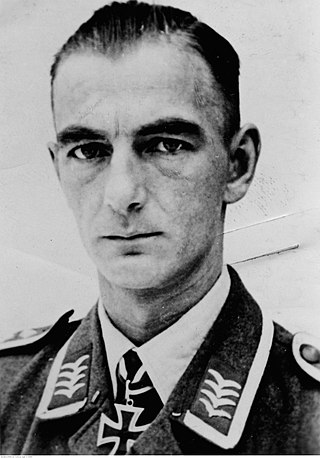Top Qs
Timeline
Chat
Perspective
Siegfried Engfer
German Luftwaffe fighter pilot From Wikipedia, the free encyclopedia
Remove ads
Siegfried Engfer (27 April 1915 – missing April 1946) was a German Luftwaffe fighter pilot during World War II and a recipient of the Knight's Cross of the Iron Cross of Nazi Germany. He was credited with 58 victories, in over 348 missions.
Remove ads
Career
Summarize
Perspective
Engfer was born on 27 April 1915 in Neuhof, present-day Będlino, in the Province of Pomerania within the German Empire.[1] On 4 June 1941, Engfer was injured during a takeoff accident in his Messerschmitt Bf 109 F-2 (Werknummer 8247—factory number) at the airfield in Norrent-Fontes.[2]
Eastern Front
The Wehrmacht launched Operation Barbarossa, the invasion of the Soviet Union, on 22 June 1941. III. Gruppe supported Army Group South in its strategic goal towards the heavily populated and agricultural heartland of Ukraine, taking Kiev before continuing eastward over the steppes of southern USSR to the Volga with the aim of controlling the oil-rich Caucasus.[3]
Both Engfer and Feldwebel Heinz Kemethmüller from 8. Staffel of JG 3 claimed their 50th aerial victories on 18 September 1942.[4] Consequently both pilots were awarded the Knight's Cross of the Iron Cross (Ritterkreuz des Eisernen Kreuzes) on 2 October 1942.[5] On 6 November, III. Gruppe was withdrawn from the Eastern Front and sent to Mannheim-Sandhofen Airfield for a period of rest and replenishment. The first elements of the Gruppe arrived by train in Mannheim on 8 December, the transfer was completed a week later. There, the personnel was sent on home leave. Following the death of Generaloberst Ernst Udet, Reichsmarschall Hermann Göring ordered JG 3 to be given the honorary name "Udet" on 1 December.[6] The Gruppe received a full complement of 41 Messerschmitt Bf 109 F-4 aircraft and on 6 January 1942 was ordered to relocated to Sicily. On 13 January, 7. Staffel and elements of 8. and 9. Staffel boarded a train to Bari in southern Italy while the rest of III. Gruppe headed for Sciacca, Sicily. The relocation progressed until 26 January when new orders were received, ordering the Gruppe to return to Germany.[7] At Jesau near Königsberg, present-day Kaliningrad in Russia, III. Gruppe began preparations for redeployment to the Eastern Front.[8] On 28 May 1943, Engfer was posted to Ergänzungs-Jagdgruppe Ost (Supplementary Fighter Group, East), a specialized training unit for new fighter pilots destined for the Eastern Front, as an instructor. Shortly after, he fell seriously ill and was infected with Tuberculosis.[9]
Engfer went missing on a train journey from Vienna to Munich in April 1946.[10] Alternatively, according to Mathews and Foreman, he may have been killed in a car accident.[11]
Remove ads
Summary of career
Summarize
Perspective
Aerial victory claims
According to US historian David T. Zabecki, Engfer was credited with 58 aerial victories.[12] Mathews and Foreman, authors of Luftwaffe Aces — Biographies and Victory Claims, researched the German Federal Archives and found documentation for 58 aerial victory claims, all of which confirmed and claimed on the Eastern Front.[13]
Awards
- Iron Cross (1939) 2nd and 1st Class[9]
- Honor Goblet of the Luftwaffe on 21 September 1942 as Feldwebel and pilot[41]
- Knight's Cross of the Iron Cross on 2 October 1942 as Feldwebel and pilot in the III./Jagdgeschwader 3 "Udet"[10][42]
Remove ads
See also
Notes
References
Wikiwand - on
Seamless Wikipedia browsing. On steroids.
Remove ads

